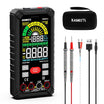A transformer is a machine that uses electromagnetic induction to move electricity between two or more circuits. In electric power applications, transformers are used to increase or decrease the alternating voltages. Transformers are used in a wide range of electronic devices, such as radios, TVs, computer networks, and power supplies.
There are two types of transformers:
· Step-up
· Step-down
A step-up transformer increases the voltage while a step-down transformer decreases the voltage. The primary winding of a transformer is wound around the core while the secondary winding is wound around the primary winding.The number of turns in the primary winding determines the voltage transformation ratio. The voltage transformation ratio is equal to the number of turns in the secondary winding divided by the number of turns in the primary winding.The secondary winding is connected to the load while the primary winding is connected to the power source.
To test a transformer with a multimeter, you will need:
- A multimeter
- A transformer

Procedure:
- Set the multimeter to the "ohms" setting.
- Touch one lead of the multimeter to one end of the primary winding and touch the other lead of the multimeter to the other end of the primary winding.
- Check the reading on the multimeter. The resistance should be low, indicating that there is continuity between the two leads. If there is no continuity, then the transformer is faulty and should be replaced.
- Touch one lead of the multimeter to one end of the secondary winding and touch the other lead of the multimeter to the other end of the secondary winding.
- Check the reading on the multimeter. The resistance should be low, indicating that there is continuity between the two leads. If there is no continuity, then the transformer is faulty and should be replaced.
Testing a transformer with a multimeter is a quick and easy way to check for continuity and proper operation. Follow these steps and you'll be able to test your transformer in no time.
Detecting transformer problems Signs:
One of the most common signs that a transformer may be having problems is an increase in operating temperature. If a transformer is running hotter than usual, it may be an indication that there is something wrong with the unit. Another sign that a transformer may be having issues is if it is making strange noises. If you hear any unusual sounds coming from your transformer, it is important to have the unit checked out by a professional as soon as possible.If you notice any of these signs, or if you have any other concerns about your transformer, be sure to contact a qualified electrical engineer or technician for further assistance. By taking early action, you can help prevent more serious problems from developing and keep your transformer running smoothly for many years to come.
Frequently Asked Questions:
Is it necessary for a transformer to have continuity?
A transformer should have continuity to ensure that the current flowing through it is uninterrupted. If there is a break in the continuity, it can cause a sudden surge of current that can damage the transformer or cause an electrical fire.
How do you test a transformer for failure?
There are several ways to test a transformer for failure. One way is to measure the loss of charge when the transformer is turned off. This can be done by measuring the voltage across the transformer's terminals with a voltmeter. Another way to test for transformer failure is to measure the current flowing through the transformer while it is turned on. This can be done by measuring the amperage with an ammeter. Finally, another way to test for transformer failure is to measure the resistance of the transformer's winding. This can be done by measuring the resistance with a ohmmeter. If any of these tests show that the transformer is not functioning properly, then it has likely failed and will need to be replaced.
What are the types of transformer testing?
There are four main types of testing that are typically performed on transformers:
- no-load tests,
- load tests,
- insulation tests,
- functional tests.
No-load tests are used to determine the transformer's iron losses and magnetizing current. Load tests are conducted to verify the transformer's capability to operate at its specified loads. Insulation tests are important for assessing the health of the transformer's insulation system. Functional testing is typically done as part of the commissioning process for new transformers or after major repairs have been made to existing units.
The most common type of transformer test is the no-load test. This test is used to measure the amount of power lost by the transformer when it is operating without any load connected to it. The no-load current and voltage are measured and used to calculate the iron losses and magnetizing current. The results of this test can be used to assess the overall health of the transformer.
Load tests are performed to verify that the transformer can operate safely at its specified loads. These tests are typically conducted by connecting a load bank to the transformer and gradually increasing the load on the unit. The transformer's voltages and currents are monitored during this test to ensure that they remain within safe limits.
Insulation tests are important for assessing the condition of the transformer's insulation system. These tests help to identify any areas of potential weakness in the insulation that could lead to problems down the line. Insulation resistance testing is commonly used for this purpose. This test measures the resistance of the insulation to an applied voltage. The results of this test can be used to determine the health of the transformer's insulation system.
Functional testing is typically done as part of the commissioning process for new transformers or after major repairs have been made to existing units. These tests help to ensure that the transformer is able to perform its intended function properly. Tests such as short-circuit impedance and capacity tests are commonly used for this purpose.
It is important to note that all four of these types of testing are important for assessing the overall condition of a transformer. However, the specific tests that are conducted will vary depending on the particular needs of the transformer in question.
Conclusion:
You must first determine the transformer's primary and secondary windings before using a multimeter to test it. You must connect the multimeter in parallel across the primary winding after determining the primary and secondary winding. The primary winding must then be exposed to an AC voltage, and the current flowing through it must then be measured. The turns ratio is finally determined by dividing the primary current by the secondary current.


































































1 comentario
shedrick
Very informative article on transformer testing
Dejar un comentario
Todos los comentarios se revisan antes de su publicación.
Este sitio está protegido por hCaptcha y se aplican la Política de privacidad de hCaptcha y los Términos del servicio.